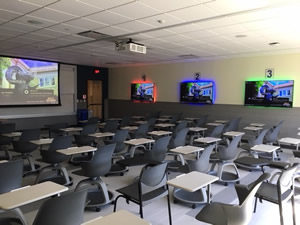Active learning continues to be a hot topic in higher education and we have had many requests to help design spaces with technology to support that teaching style. Most instructional spaces at West Chester University in Pennsylvania are designed for bring your own device (BYOD) so that students and faculty can bring in their own computers, smartphones, or tablets. We wanted to provide tech that faculty, staff, and students can access from their personal devices, regardless of hardware platform, including our learning management system, Office 365/OneDrive, virtual desktop infrastructure (VDI), cloud printing, wireless presentation, mobile on-demand lecture capture, and mobile videoconferencing.
People can access all the tech we’ve implemented, but our concern was how would we help them recognize and adopt this tech? Although we send mass emails, host faculty and student orientations and training programs, and use digital signage and our webpages, we know this can lead to communication overload and the message can get lost.
The beauty of brand names
We all know what people are talking about when we say Kleenex, Band Aid, or Xerox—all brand names, not the actual products. We see the same thing in technology. Some classic examples are Google (web searching), Smart (interactive whiteboard), and Skype (for web conferencing). To make our technologies more recognizable, we used the branding approach.
Since we are the West Chester Golden Rams, most people are familiar with the Ram name and our mascot Rammy. We all have RamCards for ID and we can load them with RamBucks to pay for things on campus. Here are some of the names we’ve used to brand the technologies particularly useful for the many BYOD devices:
- RamNet (wireless network)
- RamCast (wireless presentation)
- RamCloud (VDI)
- RamPrint (cloud printing)
RamNet, our robust wireless network, is the foundation for the success of many of our new technologies that can communicate wirelessly. We needed to support an average of three devices per person and the concentration of devices is always much higher in classrooms so a dense wireless network is a standard in classrooms.
Our approach to wireless presentation
We were looking to move away from analog VGA, address connectivity challenges, and allow faculty to be more mobile. Wireless presentation appeared to be a viable solution, and many wireless presentation solutions also support collaboration so it was a good fit for active learning. We narrowed down the options by focusing on manufacturers that offered wireless presentation as their core product because we believed there would be more investment in the research and development and not just an addition to their product line. We needed a multiplatform solution that was easy to use, secure, centrally manageable, works with AirPlay (without Bonjour) for our many iOS users, and wanted it to be appliance based (no PCs to maintain, flexible installation options, and supports our BYOD initiative).
Once we selected our product, we branded it RamCast to help with the marketing of the technology and identification. Following a test phase, we installed RamCast in 25 classrooms to include a number of faculty from different departments so we could see how it was accepted and if there were any major issues. We then implemented it in all the presentation spaces in our one-year-old Business Center and used it as the core connectivity piece in the handful of active classrooms and a few student meeting rooms. They needed flexibility to have both group and traditional lecture seating in the active classrooms so the rooms were setup with flexible seating and multiple displays.
One RamCast device is associated with each display as well as one for the projector to allow for independent group activity. The color coding and numbers associated with the displays helped with usage and identification of groups and help with routing video signals. This color and number scheme is also used on the control touch panel so any one display can be routed to all as well as all the instructor’s sources.
Another technology we have implemented is RamCloud, our virtual desktop infrastructure, which gives access to most of our university-owned software from almost anywhere.
As much as we try to go paperless, there still is a need to print. RamPrint, our cloud-printing solution, uses swipe to print technology and reduces the quantity of campus printers while also reducing paper and toner consumption. Students can print to the RamPrint cloud queue from any university computer or from their personal device, making this a more secure way to print. They use their RamID card or their network credentials to release the print job at any RamPrint location.
We scaled, standardized, and implemented these solutions using branding as part of our campus-wide BYOD initiative to help with adoption of these technologies to support active learning for our faculty and students.
- Defining a path to equitable AI in higher education - April 12, 2024
- Leveraging AI-driven edtech for continuous improvement in higher ed - April 11, 2024
- How higher ed can put the right guardrails in place to leverage AI’s power - April 9, 2024


